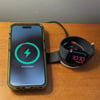Having your smartphone stolen is more than an inconvenience. With many of our online accounts tied to our smartphones for authentication, losing your phone can leave your bank accounts, credit card accounts, email accounts, and just about everything else vulnerable to theft.

If a thief gets hold of your device and is able to get past your lock screen authentication, they'll be able to access many accounts that you are already logged into, like your email. Plus, they'll be able to receive any text messages sent to your phone. Together, that provides the thief with everything they need to reset the passwords on your other critical accounts, such as your bank login, even if you have it set up for text-based two-factor authentication.
That's why it's crucial to act quickly to protect yourself as soon as possible if your phone goes missing.
Before you panic, check to see if your phone has simply been misplaced. Both Android and iOS devices have features that let you find your smartphone as long as Find My Device is enabled for Android or Find My is turned on for iPhone. Your phone will need to be powered on and have an internet connection in order to do this, but if you've misplaced it, that shouldn't be a problem.
These tools can tell you where your phone was last seen and let you play a sound to make it easier to find. If you don't find it, try to call or text it: a good Samaritan may have found your phone, and you may be able to arrange its return just by reaching out.
Once you're sure that your phone has been stolen, follow these seven steps immediately.
1. Remotely erase Your phone
Taking this step, which involves remotely factory resetting your phone, will ensure that your accounts and personal information are protected from unauthorized access.
Erase your Android phone
- Go to Find My Device. Check to ensure you’re logged in to the main Google account used for your Android phone if you have more than one Google account.
- Select your phone.
- Select Enable lock & Erase and then Erase.
You will not be able to find your phone after you erase it.
Erase your Samsung phone
- Go to SmartThings Find and log in with your Samsung account (or Google account).
- Select your phone.
- Select Erase data.
You will not be able to find your phone after you erase it.
Erase your iPhone
- Go to iCloud Find Devices and log in with your Apple ID.
- Select your phone.
- Select Erase This Device. If your iPhone is offline, the remote erase will begin as soon as your iPhone reconnects to the internet.
If your iPhone runs iOS 15 or later, you can still use Find Devices to locate or play a sound on the device.
2. Change your passwords
Even if you erased your phone quickly, you should assume that all accounts you access through your phone might have been compromised.
Change your email account passwords
You should start with your email accounts. Because email is often used for account verification, two-factor authentication, and password recovery, it's crucial for you to secure your email as soon as possible.
Change your Google Account and Apple ID account passwords
Next, change the password for your Google account (for Android) or Apple ID account (for iPhone). For Android phone owners, your Google Account is your Gmail account, so if you’ve already changed those email passwords, you’re covered.
Read more: How to Reset Your Apple ID Password
Change other important account passwords
After that, start going down the list of any important accounts you accessed on your phone, including bank accounts, social media accounts, shopping apps, and other services.
Give every account a new, unique password to keep them safe, and set up two-factor authentication if you can. If you've set up two-factor authentication tied to your phone, regaining access to your accounts or changing passwords may be challenging. However, change every account you can and set up two-factor authentication to go to another phone or an authentication app. Then, tackle the remaining accounts once you've notified your carrier and received a new SIM and phone.
3. Notify your cellular carrier
Once you've taken steps to secure your data, contact your cellular carrier to tell them your phone has been stolen. This will prevent a thief from making fraudulent charges or using your phone to scam others. Carriers will also blacklist stolen devices, preventing them from being activated in the future so a thief can't sell yours. (If you are able to recover your phone later, don't worry; you can contact your carrier again to fix it.)
Here are the steps for each of the major carriers:
- Reporting a stolen phone to AT&T
- Reporting a stolen phone to T-Mobile
- Reporting a stolen phone to Verizon
Your carrier can also help you get set up with a new device so you can keep using your existing phone number and receive the necessary two-factor authentication codes to reset any remaining account passwords.
4. Call your credit card companies
When you erase your phone, all of the credit card information in your Apple, Google, or Samsung Wallet is also erased. However, I still recommend taking the extra step of calling your credit card companies and asking for your credit card to be removed.
5. File a police report
Although the likelihood of police recovering your phone is very low, you need to file a police report. Officially documenting the theft is an important step for making insurance claims and protesting fraudulent charges. Contact your local police and be prepared to provide your phone's make, model, serial number, and IMEI number – if you don't have this information, your carrier should be able to provide it.
6. Make an insurance claim
You may be able to file an insurance claim to replace your stolen phone. While you should expect to pay a deductible to replace your phone, it will usually be less than the replacement cost. Here are the types of insurance you may have available to you that could cover your phone.
Phone insurance
If you have phone insurance from your carrier, there’s a good chance that it covers theft. Apple also has a tier of insurance called AppleCare+ with Theft and Loss, and Samsung offers Samsung Care+ Theft and Loss.
Credit card insurance
If you bought the phone on a credit card, your credit card issuer may cover the loss under its purchase protection program. And even if the phone is older, it may still be covered if you use your credit card to pay your phone bill.
Homeowners or renters insurance
Homeowners insurance or renters insurance may cover your phone. Check your insurance coverage to see if phones are included.
7. Monitor Your Accounts
While taking the steps above should protect your data, there's always a chance that a thief got into one of your accounts anyway. So, it's important to remain vigilant.
Monitor all of your online services for fraudulent activity and charges, particularly your bank and credit card accounts. If you see any fraudulent financial activity, contact your bank immediately to dispute charges and cancel compromised cards.
Watch your credit report to make sure you aren't the target of identity theft (or sign up for a credit monitoring service to do it for you). You may also want to contact the credit bureaus to freeze your credit so no one can open accounts in your name.
Read more: How to Add a Credit Freeze or Fraud Alert
With quick action, you should be able to lessen the risks of financial and identity theft when your phone is stolen. And with ongoing vigilance, you can minimize long-term harm.
[Image credit: thief steals phone via BigStockPhoto]
Elizabeth Harper is a writer and editor with more than a decade of experience covering consumer technology and entertainment. In addition to writing for Techlicious, she was the Editorial Director of Blizzard Watch, and is published on sites all over the web, including Time, CBS, Engadget, The Daily Dot, and DealNews.












